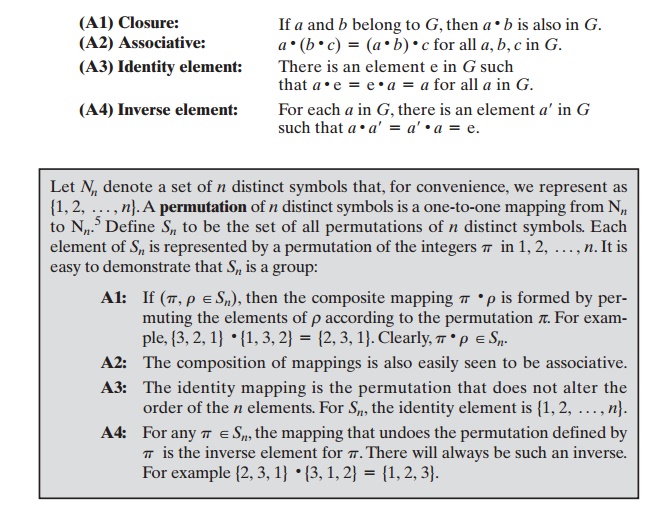Chapter: Cryptography and Network Security Principles and Practice : One Symmetric Ciphers : Basic Concepts in Number Theory and Finite Fields
Groups, Rings, and Fields
GROUPS, RINGS, AND FIELDS
Groups, rings, and fields are the fundamental elements of a branch of mathematics
known as abstract algebra, or modern algebra.
In abstract algebra,
we are concerned with sets on whose elements
we can operate algebraically; that is, we can combine
two elements of the set, perhaps in several ways, to obtain a third element
of the set. These operations are subject to specific rules,
which define the nature of the set. By
convention, the notation
for the two principal classes
of operations on set elements is usually the same as the notation for addition and multiplication on ordinary num- bers. However,
it is important to note that, in abstract algebra,
we are not limited to ordinary arithmetical operations. All this should
become clear as we proceed.
Groups
A group G, sometimes denoted by {G, # }, is a set of elements with a binary
operation
denoted
by # that associates to each ordered pair (a, b) of elements in G an element
(a # b) in G, such that the
following axioms are obeyed:

If
a group has a finite number of elements, it is referred to as a finite group, and the order of the group is equal to the
number of elements in the group. Otherwise, the group is an infinite group.
A group is said to be abelian if
it satisfies the following additional condition:

The set of integers (positive, negative, and 0) under addition
is an abelian group. The set of nonzero
real numbers under multiplication is an abelian
group. The set Sn from the preceding example
is a group but not an abelian
group for n > 2.
When the group operation is addition, the identity element is 0; the inverse element of a is –a; and subtraction is defined with the following rule:
a - b = a + (-b).
CYCLIC GROUP We define exponentiation within a group as a
repeated appli- cation of the group operator,
so that a3 = a a a. Furthermore, we define a0 = e as the identity element, and a - n = (a')n, where a' is the inverse element of a within the group. A group G is cyclic if every element of G is a power ak (k is an integer)
of a fixed element a H G.
The element a is said to generate the group G or
to be a generator of G. A
cyclic group is always abelian and may be finite or
infinite.
The additive group of
integers is an infinite cyclic group generated by the element 1. In this case,
powers are interpreted additively, so that n is the nth power of 1.
Rings
A ring R,
sometimes denoted by {R,
+, *},
is a set
of elements
with two
binary operations, called addition and multiplication,6 such
that for all a,
b,
c in
R the
following axioms are
obeyed.

In essence, a ring is a set in which we can do addition, subtraction [a - b = a + (-b)], and multiplication without leaving the set.
With
respect to addition and multiplication, the set of all n-square matrices over
the real numbers is a ring.
A ring is said to be commutative if it satisfies the following additional condition:
(M4) Commutativity of
multiplication: ab = ba for all a, b in R.
Let S be the set of even integers (positive, negative, and 0) under the usual opera- tions of addition
and multiplication. S is a commutative ring. The set
of all n-square matrices defined in the preceding example is not a commutative ring.
The set Zn of integers {0, 1, ... , n - 1}, together
with the arithmetic operations
modulo n, is a commutative ring (Table 4.3).
Next, we define
an integral domain, which
is a commutative ring that
obeys the following axioms.
(M5) Multiplicative identity: There is an
element 1 in R such that a1 = 1a = a for all a in R.
(M6) No zero
divisors: If a, b in R and ab =
0, then either a = 0
or
b = 0.
Let S be the set of integers, positive, negative,
and 0, under the usual operations of addition and multiplication. S is an
integral domain.
Fields
A
field F, sometimes denoted by {F, +, x}, is a set of elements with two binary opera- tions,
called addition and multiplication, such that for all a, b,
c in F the following axioms are obeyed.
(A1–M6)
F
is an integral domain; that is, F satisfies axioms A1 through A5 and M1
through M6.
(M7) Multiplicative inverse: For each a
in F, except 0, there is an
element
a - 1 in F such
that aa - 1 = (a - 1)a = 1.
In essence,
a field is a set in which
we can do addition,
subtraction, multiplication,
and division without leaving the set. Division is defined with the
following rule: a/b = a(b -
1).
Familiar examples of fields are the rational numbers, the real
numbers, and the complex numbers. Note that the set of all integers is not a
field, because not every element of the set has a multiplicative inverse; in
fact, only the elements 1 and –1 have multiplicative inverses in the integers.
Figure
4.2 summarizes the axioms that define groups, rings, and fields.

Related Topics